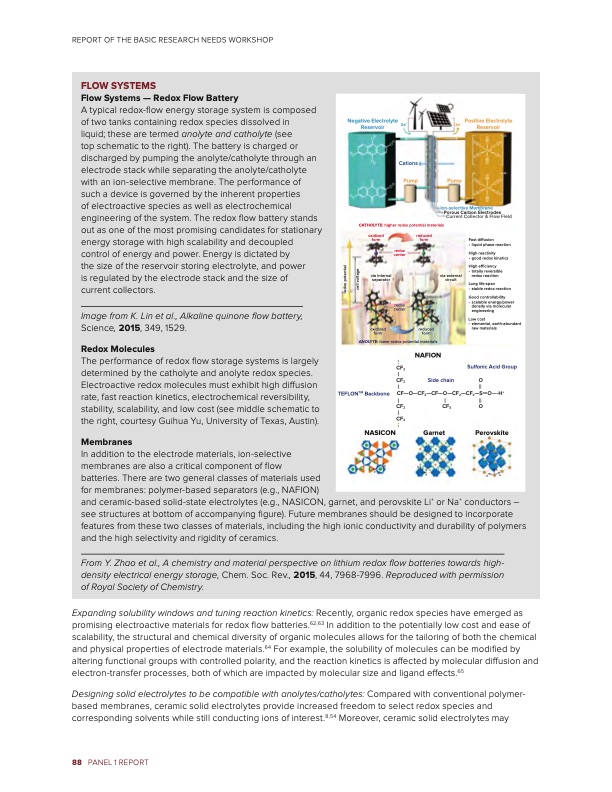
PDF Publication Title:
Text from PDF Page: 094
REPORT OF THE BASIC RESEARCH NEEDS WORKSHOP FLOW SYSTEMS Flow Systems — Redox Flow Battery A typical redox-flow energy storage system is composed of two tanks containing redox species dissolved in liquid; these are termed anolyte and catholyte (see top schematic to the right). The battery is charged or discharged by pumping the anolyte/catholyte through an electrode stack while separating the anolyte/catholyte with an ion-selective membrane. The performance of such a device is governed by the inherent properties of electroactive species as well as electrochemical engineering of the system. The redox flow battery stands out as one of the most promising candidates for stationary energy storage with high scalability and decoupled control of energy and power. Energy is dictated by the size of the reservoir storing electrolyte, and power is regulated by the electrode stack and the size of current collectors. Image from K. Lin et al., Alkaline quinone flow battery, Science, 2015, 349, 1529. Redox Molecules The performance of redox flow storage systems is largely determined by the catholyte and anolyte redox species. Electroactive redox molecules must exhibit high diffusion rate, fast reaction kinetics, electrochemical reversibility, stability, scalability, and low cost (see middle schematic to the right, courtesy Guihua Yu, University of Texas, Austin). Membranes In addition to the electrode materials, ion-selective membranes are also a critical component of flow batteries. There are two general classes of materials used for membranes: polymer-based separators (e.g., NAFION) and ceramic-based solid-state electrolytes (e.g., NASICON, garnet, and perovskite Li+ or Na+ conductors – see structures at bottom of accompanying figure). Future membranes should be designed to incorporate features from these two classes of materials, including the high ionic conductivity and durability of polymers and the high selectivity and rigidity of ceramics. From Y. Zhao et al., A chemistry and material perspective on lithium redox flow batteries towards high- density electrical energy storage, Chem. Soc. Rev., 2015, 44, 7968-7996. Reproduced with permission of Royal Society of Chemistry. Negative Electrolyte 2e– Reservoir Cations 2e– Positive Electrolyte Reservoir CATHOLYTE: higher redox potential materials oxidized form via internal separator oxidized form reduced form reduced form redox center redox center Fast diffusion • liquid phase reaction High reactivity • good redox kinetics High efficiency • totally reversible redox reaction Long life-span • stable redox reaction Good controllability • scalable energy/power density via molecular engineering Low cost • elemental, earth-abundant raw materials Garnet Perovskite c aba ANOLYTE: lower redox potential materials NAFION TEFLONTM Backbone NASICON bb a O CF3 O Pump Pump Ion-selective Membrane Porous Carbon Electrodes Current Collector & Flow Field via external circuit CF2 CF2 Side chain CF—O—CF2—CF—O—CF2—CF2—S= O----H+ CF2 CF2 Sulfonic Acid Group Expanding solubility windows and tuning reaction kinetics: Recently, organic redox species have emerged as promising electroactive materials for redox flow batteries.62,63 In addition to the potentially low cost and ease of scalability, the structural and chemical diversity of organic molecules allows for the tailoring of both the chemical and physical properties of electrode materials.64 For example, the solubility of molecules can be modified by altering functional groups with controlled polarity, and the reaction kinetics is affected by molecular diffusion and electron-transfer processes, both of which are impacted by molecular size and ligand effects.65 Designing solid electrolytes to be compatible with anolytes/catholytes: Compared with conventional polymer- based membranes, ceramic solid electrolytes provide increased freedom to select redox species and corresponding solvents while still conducting ions of interest.8,54 Moreover, ceramic solid electrolytes may 88 PANEL 1 REPORT ... — — — — ... — == redox potential cell voltagePDF Image | Next Generation Electrical Energy Storage

PDF Search Title:
Next Generation Electrical Energy StorageOriginal File Name Searched:
BRN-NGEES_rpt-low-res.pdfDIY PDF Search: Google It | Yahoo | Bing
Sulfur Deposition on Carbon Nanofibers using Supercritical CO2 Sulfur Deposition on Carbon Nanofibers using Supercritical CO2. Gamma sulfur also known as mother of pearl sulfur and nacreous sulfur... More Info
CO2 Organic Rankine Cycle Experimenter Platform The supercritical CO2 phase change system is both a heat pump and organic rankine cycle which can be used for those purposes and as a supercritical extractor for advanced subcritical and supercritical extraction technology. Uses include producing nanoparticles, precious metal CO2 extraction, lithium battery recycling, and other applications... More Info
| CONTACT TEL: 608-238-6001 Email: greg@infinityturbine.com | RSS | AMP |